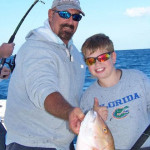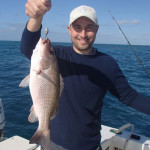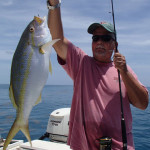April is a big fish month. It doesn’t matter if you prefer inshore or off, April heralds the arrival of the big boys. If you are an offshore fan, you know that the largest dolphin start to arrive now. And if you prefer to fish in more protected water you will welcome the arrival of the annual tarpon migration.

As you have been told, I tend to suffer from an affliction known as fishing ADD. Getting the most out of a day is a challenge that I love to step up to. Choosing between these Florida Keys greats is not something that you have to do, as they are not mutually exclusive. While it cannot be done in the same location, it is easy to accomplish both on the same trip.
The key to getting a crack at both in a single charter is to get an early start. Most of us travel through productive tarpon water on our way offshore to find dolphin. Taking a few hours to stop during the prime time of tarpon feeding is usually just a matter of getting out an hour or two earlier.
Tarpon congregate in the channels that lead to open water to feed. Most of this feeding is done near sunrise and sunset. If you can get out about an hour before sunrise you can set up in the tarpon’s primary feeding location during their primary feeding time. If you’re like me you don’t travel anywhere without a baitwell filled with pinfish, you already have all of the components necessary to do battle with these inshore giants.
Find a choke point in the channel. Where the channels are at their narrowest, they are often also at their deepest. Here is where the tarpon will congregate to forage. If there is a bridge between you and open water it will usually create the choke point. Anchor just upstream of the point by a hundred feet or so and you are ready to present a bait. I like to float a large lip hooked pinfish back about fifty feet behind the boat and another about one hundred feet back. A large circle hook on about eight to twelve feet of sixty to eighty pound fluorocarbon makes the ideal terminal rig. If you happen to have a large blue crab, split the difference between to two pinfish and round out the offering.
About an hour after sunrise the best of the bite will be slowing and you will be able to pull anchor knowing that you have had the best of the day’s tarpon bite, and you are only just starting your day of fishing. From there it is a quick run out to blue water to start your search for the most popular offshore fish in the Keys.
April dolphin, are usually found cruising down sea quickly, going who knows where. While they are often termed “cruising fish”, the term cruise is misleading. These fish are really moving. Just lucking into their path is not always a guarantee of success. Finding the fast moving birds that betray their presence is the key to success. Whether it is terns or the ever popular frigate bird, they are the best indicator of fish. These speed racers often are traveling up to about ten knots. These speeds are usually reserved for members of the tuna family. If you find birds holding over fish moving at these speeds later in the year, you can wager that they are not dolphin, and come out money on top.
If you are trolling naked ballyhoo, be prepared to replace them often. Better yet, keep them well dressed. A skirt or lure combination will last significantly longer than an undressed bait.
Between finding fish you can back down to normal trolling speed of between five and six knots. This will not only help preserve your bait it will give a lot of relief to your fuel bill. When the next bird comes rushing by, you can go back to the chase and get your bait out in front of the fish. You should also be careful to not run over your fish. While the fish and his shadowing bird will tend to track back and forth a lot, you should try to stay off to the side as you are overtaking them. When you are clearly out in front, only then should you get your bait into their path. While overtaking a fish it is not uncommon to actually see the fish rushing along the surface. Take advantage of this possibility by having a pitch rod ready. I keep one baited with a live pinfish. Don’t bother to slow down, just pitch the bait in front of the dolphin and more often than not he will inhale it without ever slowing down.
When you are trolling at these speeds stretching in your line helps to keep break offs and pulled hooks to a minimum. If you choose to use braided lines for trolling you are giving up all of the stretching properties found in monofilament. One thing that I have found that puts the stretch back in your rig, is to use Nickel titanium leaders. Knot 2 Kinky brand from www.aquateko.com makes a leader that has several unique properties. Being nearly kinkproof is one asset, being practically corrosion proof is another; however the most important asset is that the wire actually has an elastic property and will stretch fifteen percent and return without fatiguing the wire. You will need to rig differently than with stainless wire. Instead of the haywire twist used in stainless wire you can accomplish the same task by simply knotting the wire using a perfection loop. While it does cost considerably more than stainless, it offsets it’s cost by being indefinitely reusable.
Remember that these fish average over twenty pounds and finding fish in the forty pound range barely lifts an eyebrow. It doesn’t take many to make for quite a haul. Another difference between these fish and the school sized ones found later in the year is that the buddies of the hooked fish rarely hang around their brethren the way fish will tend to do late in the year. So if you get a hookup it pays to keep your trolling speed up for a few extra seconds to increase the odds of a double or better header.
Even with my fishing ADD I have had to slow down a little in my quickly advancing years. That is to say that I rarely stop on the way home to fish the sunset tide as well as the sunrise.




